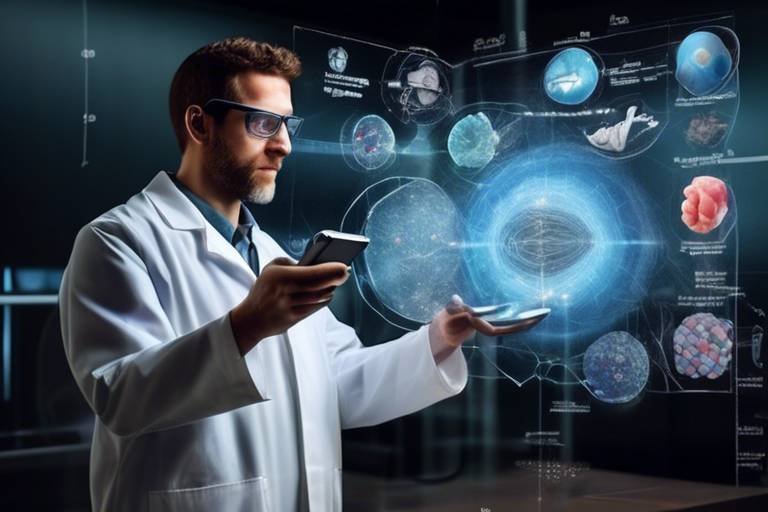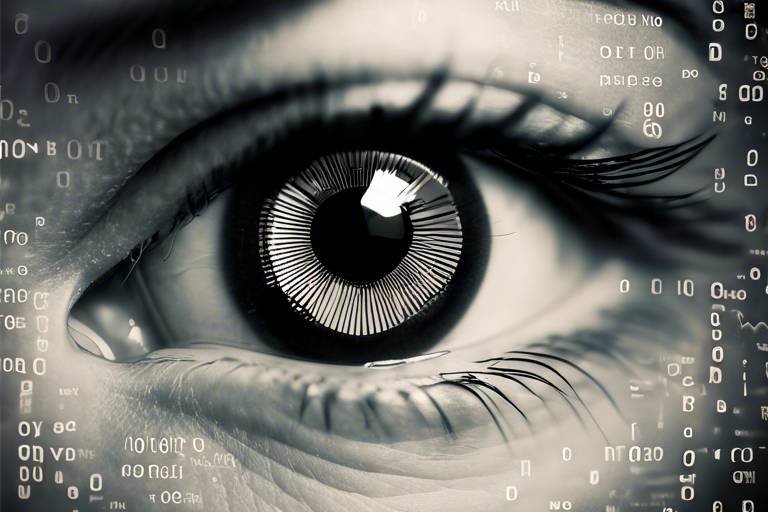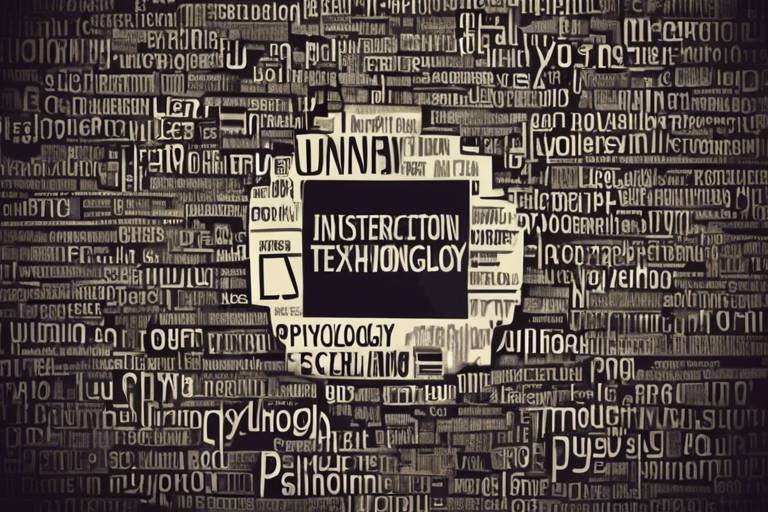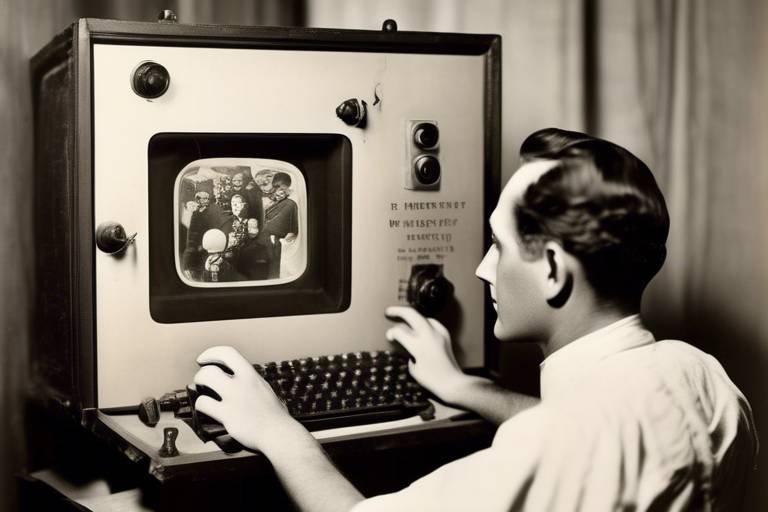How Augmented Reality is Used in Scientific Visualization
In today's fast-paced world, the integration of technology into various fields has become indispensable, and augmented reality (AR) is at the forefront of this revolution. By overlaying digital information onto the real world, AR provides a unique way to visualize complex scientific concepts and data. Imagine walking through a laboratory and seeing molecular structures floating in the air, or viewing a 3D model of the human heart while discussing anatomy with a peer. This is not science fiction; it’s the transformative power of AR in scientific visualization.
AR enhances our understanding of scientific phenomena by making abstract concepts tangible. It bridges the gap between theoretical knowledge and practical application, allowing scientists, students, and researchers to interact with data in ways that were previously unimaginable. By engaging multiple senses, AR creates an immersive experience that can lead to better retention of information and improved problem-solving skills.
As we delve deeper into the various applications of AR across different scientific fields, it’s essential to recognize the incredible potential it has to revolutionize education, medicine, environmental science, engineering, and beyond. The journey of AR is just beginning, and its impact on scientific visualization is profound, paving the way for innovations that could redefine how we perceive and interact with the world around us.
At its core, augmented reality enhances our perception of reality by adding layers of digital information to our physical environment. Unlike virtual reality (VR), which immerses users in a completely digital world, AR allows users to see and interact with both the real and digital worlds simultaneously. The fundamental components of AR include:
- Hardware: Devices such as smartphones, tablets, and AR glasses that display augmented content.
- Software: Applications that create and manage the digital overlays.
- Content: The digital information that is projected onto the real world, which can include 3D models, animations, and data visualizations.
This unique blend of reality and digital information enables scientists to visualize complex datasets and phenomena in real-time, making it easier to analyze and understand intricate details that might otherwise remain hidden.
In the medical field, AR is making waves by transforming how training and patient care are approached. For instance, surgeons can use AR to visualize a patient's anatomy in 3D before performing complex procedures. This technology not only enhances surgical precision but also reduces the risk of complications. Furthermore, AR is being utilized in anatomy education, allowing students to explore the human body interactively, which significantly improves their understanding of complex systems.
Moreover, AR enhances patient engagement by providing interactive visualizations that help patients understand their conditions better. Imagine a patient being able to see a 3D representation of their tumor alongside real-time data about its growth and response to treatment. This kind of visualization can empower patients, making them active participants in their healthcare journey.
AR is revolutionizing educational settings by offering immersive learning experiences that captivate students' attention. In classrooms, AR tools are being integrated to visualize complex scientific concepts, such as chemical reactions or astronomical phenomena. Instead of reading about the solar system in a textbook, students can explore it through AR, seeing planets orbiting in real-time around a virtual sun.
This interactive approach not only makes learning more engaging but also caters to different learning styles. Visual learners benefit from seeing concepts in action, while kinesthetic learners can interact with the material, enhancing their understanding and retention. With AR, education becomes a dynamic experience rather than a passive one.
Environmental scientists are leveraging AR to visualize data in real-time, which is crucial for understanding complex issues like climate change and biodiversity. For instance, AR can project data onto landscapes, showing how environmental changes impact ecosystems. Imagine hiking through a forest and seeing an overlay of data indicating the health of various species or the effects of pollution on the local flora and fauna.
This kind of visualization not only aids researchers in their studies but also helps the public understand the importance of environmental conservation. By making data accessible and visually engaging, AR fosters a greater appreciation for our planet and the challenges it faces.
In engineering and design, AR is a game-changer for prototyping and visualization. Engineers can create virtual models of their designs and view them in the real world, allowing for better collaboration and communication among teams. This technology streamlines the engineering process by enabling real-time modifications and assessments, ultimately improving design accuracy.
For example, architects can use AR to visualize how a new building will look in its environment, assessing factors like sunlight and shadows. This not only enhances creativity but also ensures that designs are practical and aesthetically pleasing.
Despite its potential, the implementation of AR in scientific visualization is not without challenges. Technical hurdles, such as the need for advanced hardware and software, can be significant barriers. Additionally, the financial investment required for AR technology may deter some institutions from adopting it.
Moreover, ethical considerations must also be addressed, particularly regarding data privacy and the accuracy of the information presented. Ensuring that AR applications are reliable and trustworthy is crucial for their acceptance in scientific communities.
The future of AR in scientific visualization looks bright, with emerging technologies and trends promising to enhance its applications further. Developments in artificial intelligence (AI) and machine learning could enable AR systems to provide even more personalized and context-aware experiences. Imagine AR applications that adapt in real-time to a user’s specific needs, offering tailored data visualizations based on their queries.
As AR technology continues to evolve, we can expect to see more sophisticated tools that integrate seamlessly into scientific workflows, making data visualization more intuitive and impactful.
Real-world examples of AR's impact on scientific visualization provide valuable insights into its effectiveness. For instance, a university used AR to enhance its biology curriculum, allowing students to dissect virtual frogs. This not only reduced costs but also provided a safe and engaging learning environment.
Another example can be seen in the healthcare sector, where a hospital used AR for surgical training. Surgeons-in-training could practice procedures on virtual patients, significantly improving their skills before operating on real patients. These case studies highlight the tangible benefits of AR in various scientific fields.
User experience is crucial for the success of AR applications. If the technology is not intuitive or user-friendly, it may hinder rather than enhance the learning experience. Design principles that prioritize user-centered approaches ensure that AR tools are accessible and beneficial for scientific visualization.
By focusing on the needs and preferences of users, developers can create AR applications that not only provide valuable insights but also engage users in meaningful ways, ultimately leading to better outcomes in scientific exploration.
Q1: What is augmented reality?
A1: Augmented reality (AR) is a technology that overlays digital information onto the real world, enhancing our perception of reality.
Q2: How is AR used in education?
A2: AR is used in education to provide immersive learning experiences, allowing students to visualize complex concepts interactively.
Q3: What are the challenges of implementing AR in scientific visualization?
A3: Challenges include technical hurdles, financial investment, and ethical considerations regarding data privacy and accuracy.
Q4: What is the future of AR in scientific visualization?
A4: The future looks promising, with advancements in AI and machine learning expected to enhance AR applications further.

Understanding Augmented Reality
Augmented Reality, commonly known as AR, is a groundbreaking technology that enhances our perception of the real world by overlaying digital information onto it. Imagine walking through a museum, and as you gaze at a painting, your smartphone or AR glasses provide you with historical context, artist insights, and even animations that bring the artwork to life. This fascinating blend of the physical and digital realms is what makes AR so compelling.
At its core, AR is composed of three main components: hardware, software, and content. The hardware includes devices like smartphones, tablets, and specialized AR glasses that capture the real world and display digital overlays. The software is responsible for processing the data and rendering the augmented elements in real-time. Lastly, the content encompasses the digital information that is displayed, which can range from simple text and images to complex 3D models and animations.
One of the key distinctions between AR and its sibling technology, Virtual Reality (VR), lies in their interaction with the real world. While VR immerses users in a completely virtual environment, isolating them from reality, AR enhances the real world by adding layers of digital information to it. This means that users can still interact with their physical surroundings while engaging with augmented content. Think of AR as a pair of glasses that not only help you see but also provide you with extra information about what you're looking at.
The applications of AR are vast and varied, impacting numerous fields including education, healthcare, engineering, and entertainment. For instance, in education, AR can transform a dull textbook into a vibrant, interactive experience, allowing students to visualize complex scientific concepts in a way that is engaging and memorable. In healthcare, surgeons can use AR to visualize critical information during operations, improving precision and patient outcomes.
To better understand the difference between AR and VR, let's take a look at the following table:
| Feature | Augmented Reality (AR) | Virtual Reality (VR) |
|---|---|---|
| Interaction with Reality | Enhances the real world | Creates a completely virtual environment |
| Device Requirements | Smartphones, tablets, AR glasses | VR headsets |
| Applications | Education, healthcare, retail, gaming | Gaming, simulations, training |
| User Experience | Interactive with real-world elements | Immersive and isolating |
As we continue to explore the potential of AR, it's essential to understand how it can be effectively integrated into various fields. The synergy between the digital and physical worlds opens up new avenues for innovation. Whether it's helping students grasp scientific principles or assisting surgeons during complex operations, the possibilities are endless. With each advancement, AR is not just a tool; it is a bridge that connects our reality with a world of information, making it an invaluable asset in scientific visualization and beyond.

Applications in Medicine
Augmented Reality (AR) is not just a buzzword; it is a game-changer in the medical field. Imagine a world where surgeons can visualize intricate anatomical structures while performing operations, or where medical students can engage in lifelike simulations that enhance their learning experience. This is not science fiction; it's happening right now! AR is revolutionizing how we approach medical training and patient care, making procedures safer and educational experiences more effective.
One of the most significant applications of AR in medicine is in surgical simulations. Surgeons can practice complex procedures in a risk-free environment, allowing them to hone their skills before stepping into the operating room. For example, AR systems can overlay digital images of a patient's anatomy onto their body during surgery, providing real-time guidance and improving precision. This technology not only enhances the surgeon's confidence but also increases the likelihood of successful outcomes.
Furthermore, AR is transforming anatomy education. Traditional methods often rely on textbooks and static images, which can be limiting. With AR, students can interact with 3D models of the human body, allowing them to explore structures from various angles and gain a deeper understanding of complex systems. This interactive approach caters to different learning styles, making it easier for students to grasp challenging concepts. For instance, a student can visualize the circulatory system in real-time, observing how blood flows through the heart and vessels, which is far more impactful than simply reading about it.
Another fascinating application of AR in medicine is in patient engagement. Imagine a patient diagnosed with a condition that requires surgery. With AR, doctors can show the patient a 3D model of their own anatomy, explaining the procedure and what to expect. This not only demystifies the surgical process but also empowers patients by involving them in their own healthcare decisions. It’s like having a personal tour guide through the complex landscape of their own body!
To illustrate the impact of AR in medicine, consider the following table that summarizes key applications:
| Application | Description | Benefits |
|---|---|---|
| Surgical Simulations | AR overlays anatomical data during surgery. | Improves precision and outcomes. |
| Anatomy Education | 3D models allow for interactive learning. | Enhances understanding and retention. |
| Patient Engagement | Visual aids help patients understand procedures. | Empowers patients and improves satisfaction. |
In summary, the applications of AR in medicine are vast and varied, offering unprecedented opportunities for enhancing both training and patient care. As technology continues to evolve, we can expect even more innovative uses of AR that will further transform the healthcare landscape, making it more efficient, effective, and patient-centered.

Advancements in Education
Augmented Reality (AR) is not just a buzzword in the tech world; it’s a revolutionary tool that’s reshaping the educational landscape. Imagine walking into a classroom where the walls come alive with interactive 3D models of the solar system or the human body. Sounds like science fiction? Well, it’s a reality today! AR technology is providing students with immersive experiences that traditional teaching methods simply can't match. This engaging form of learning captivates students' attention and enhances their understanding of complex scientific concepts.
One of the most significant advancements AR brings to education is its ability to transform abstract concepts into tangible experiences. For instance, in a biology class, students can use AR applications to visualize the intricate details of cellular structures. Instead of just reading about cell division from a textbook, they can manipulate 3D models of cells, observing the process in real-time. This hands-on approach not only makes learning more enjoyable but also reinforces retention of information. It’s like having a personal tutor that brings lessons to life!
Moreover, AR fosters collaboration among students. When working on group projects, students can share AR experiences that allow them to explore concepts together, enhancing teamwork and communication skills. For example, in a physics class, students can collaboratively experiment with forces and motion using AR simulations, making learning a shared adventure. This collaborative aspect is crucial as it prepares students for real-world scenarios where teamwork is essential.
In addition to enhancing engagement and collaboration, AR also caters to diverse learning styles. Every student learns differently; some are visual learners, while others may prefer auditory or kinesthetic methods. AR addresses these varying needs by offering multiple ways to interact with content. For example, students can engage with AR through:
- Visual aids: 3D models and animations that illustrate complex processes.
- Interactive simulations: Hands-on experiences that allow students to experiment and learn by doing.
- Audio elements: Narrations and sound effects that enhance the learning experience.
Furthermore, educators are increasingly adopting AR tools to supplement their teaching. Many schools are integrating AR into their curricula, providing teachers with innovative resources to engage their students. This shift not only enriches the learning environment but also prepares students for a future in which digital literacy will be paramount.
However, it’s essential to recognize that the implementation of AR in education is not without its challenges. Schools must invest in the necessary technology and training for teachers to effectively utilize AR tools. Additionally, there are concerns about accessibility, as not all students may have equal access to AR devices or applications. Addressing these issues is crucial for ensuring that the benefits of AR are available to all students.
In conclusion, the advancements in education brought about by augmented reality are truly remarkable. By making learning interactive, collaborative, and tailored to individual needs, AR is not just enhancing educational experiences; it’s transforming them. As we continue to explore the potential of this technology, we can only imagine the exciting possibilities that lie ahead in the realm of education.
Q1: How does AR enhance learning in the classroom?
A1: AR enhances learning by providing interactive and immersive experiences that make complex concepts more understandable and engaging for students.
Q2: Are there any challenges to implementing AR in education?
A2: Yes, challenges include the need for investment in technology, training for teachers, and ensuring accessibility for all students.
Q3: Can AR cater to different learning styles?
A3: Absolutely! AR can provide visual, auditory, and kinesthetic learning experiences, catering to various learning preferences.

Environmental Science and AR
In the realm of environmental science, augmented reality (AR) is proving to be a game-changer, allowing scientists and researchers to visualize complex data in ways that were previously unimaginable. Imagine standing in a forest and, with the help of AR glasses, seeing real-time data about the biodiversity around you. You could view the population density of various species, the health of trees, or even the impact of climate change—all overlaid onto your natural surroundings. This immersive experience not only enhances understanding but also fosters a deeper connection to the environment.
One of the most significant advantages of AR in environmental science is its ability to present interactive data representations. By integrating AR into field studies, scientists can engage with data dynamically. For instance, during a climate change study, researchers can visualize temperature changes over the years by simply pointing their device at specific locations. This immediate feedback loop allows for quicker adjustments in research methodologies and enhances the overall quality of data collection.
Moreover, AR facilitates collaboration among scientists, educators, and the public. Consider a community meeting focused on local conservation efforts. Using AR, participants can visualize proposed changes to their environment, such as the impact of a new park or the effects of pollution. This visualization helps to demystify scientific concepts for the general public, making them more accessible and understandable. It also encourages community involvement in environmental initiatives, as people can see the potential outcomes of their actions in real-time.
In addition to these applications, AR is also being utilized for educational purposes. Schools and universities are incorporating AR tools into their curricula to teach students about ecology and environmental science. For example, students can use AR apps to explore ecosystems, learning about food webs, species interactions, and the delicate balance of nature right from their classrooms. This hands-on approach not only makes learning more engaging but also instills a sense of responsibility towards the environment.
To illustrate the potential of AR in environmental science, here’s a brief overview of some key applications:
| Application | Description |
|---|---|
| Real-time Data Visualization | Overlaying climate data on geographical locations to analyze environmental changes. |
| Species Tracking | Using AR to monitor wildlife populations and their habitats in real-time. |
| Public Engagement | Enhancing community understanding of environmental issues through interactive displays. |
| Educational Tools | Creating immersive learning experiences for students studying ecology and the environment. |
As we continue to face pressing environmental challenges, the integration of augmented reality into scientific visualization is more crucial than ever. It not only enhances our ability to analyze and understand ecological data but also empowers individuals and communities to take action. By bridging the gap between complex scientific information and public understanding, AR is paving the way for a more informed and engaged society in the fight against environmental degradation.
- What is augmented reality? Augmented reality (AR) is a technology that overlays digital information onto the real world, enhancing our perception of our surroundings.
- How does AR benefit environmental science? AR allows for real-time data visualization, enhancing understanding and engagement with environmental issues, and facilitating collaboration among scientists and the public.
- Can AR be used in education? Absolutely! AR provides immersive learning experiences, making complex ecological concepts more accessible and engaging for students.
- What are some examples of AR applications in environmental science? Examples include real-time data overlays for climate studies, species tracking, and interactive displays for public engagement.

AR in Engineering and Design
Augmented Reality (AR) is making waves in the fields of engineering and design, transforming how professionals visualize and interact with their projects. Imagine walking into a room and seeing a full-scale prototype of a bridge or a car, right there in front of you, as if it were already built. This is not science fiction; it's the reality that AR brings to the table. By overlaying digital models onto the physical world, AR allows engineers and designers to see their creations in context, making it easier to identify potential issues before they become costly problems.
One of the most significant advantages of AR in engineering is its ability to enhance collaboration. Teams can work together in real-time, regardless of their physical locations. For instance, an engineer in New York can collaborate with a designer in Tokyo, both viewing the same 3D model through their AR devices. This not only speeds up the design process but also fosters innovation as diverse perspectives come together seamlessly. Imagine brainstorming with colleagues while simultaneously manipulating a 3D model—it's like having a virtual workshop at your fingertips!
Furthermore, AR improves design accuracy. Traditional methods often rely on 2D blueprints, which can be misleading. With AR, engineers can visualize complex systems in three dimensions, allowing them to understand spatial relationships and interdependencies better. This capability is especially beneficial in fields such as architecture and civil engineering, where the integration of various components is crucial. For example, AR can help visualize how electrical systems will fit within the walls of a new building, ensuring that everything is planned perfectly before any physical work begins.
However, it's not just about visualization; AR also streamlines the engineering process. By using AR for prototyping, teams can create virtual models that can be tested and modified in real-time. This rapid iteration cycle means that feedback can be incorporated immediately, reducing the time spent on revisions and enhancing overall productivity. In fact, studies have shown that projects that utilize AR can complete design phases up to 30% faster compared to traditional methods.
To illustrate the impact of AR, consider the following table that summarizes key benefits:
| Benefits of AR in Engineering and Design | Description |
|---|---|
| Enhanced Collaboration | Real-time interaction among team members, regardless of location. |
| Improved Accuracy | 3D visualization helps in understanding complex spatial relationships. |
| Streamlined Prototyping | Rapid iteration and immediate feedback reduce design time. |
| Cost Efficiency | Identifying potential issues early saves time and resources. |
In conclusion, the integration of AR into engineering and design is not just a trend—it's a revolution. As technology continues to advance, we can expect even more innovative applications of AR that will further enhance how we design and build our world. So, the next time you think about the future of engineering, remember that AR is not just enhancing the way we visualize; it's reshaping our entire approach to design and collaboration.
- What is Augmented Reality (AR)? AR is a technology that overlays digital information onto the real world, enhancing our perception of our environment.
- How does AR improve collaboration in engineering? AR allows team members to interact with the same 3D models in real-time, regardless of their physical location.
- Can AR help reduce costs in engineering projects? Yes, by identifying potential issues early in the design process, AR can save time and resources, ultimately reducing project costs.
- What industries benefit the most from AR in design? Industries such as architecture, civil engineering, automotive, and aerospace are among those that benefit significantly from AR technologies.

Challenges of Implementing AR
While the potential of Augmented Reality (AR) in scientific visualization is undeniably exciting, the road to its widespread implementation is paved with numerous challenges. One of the most significant hurdles is the technical complexity involved in developing AR applications. Creating a seamless integration of digital content with the physical world requires advanced software and hardware capabilities, which can be both time-consuming and costly. Furthermore, the need for high-quality graphics and real-time processing can strain existing technological infrastructures, especially in fields like medicine and engineering where precision is paramount.
Another challenge is the financial investment required for AR technology. Many institutions, particularly in academia and non-profit sectors, may find it difficult to allocate sufficient funds for AR projects. This financial barrier can limit the scope of research and development, preventing many organizations from exploring AR's full potential. Additionally, the cost of maintaining and updating AR systems can be daunting, especially when considering the rapid pace of technological advancement.
Moreover, there are ethical concerns surrounding the use of AR in sensitive fields such as healthcare. For instance, the use of AR in surgical simulations raises questions about patient privacy and data security. How can medical professionals ensure that patient information remains confidential while utilizing AR tools? Addressing these ethical dilemmas is crucial to gaining trust from both practitioners and patients alike. Furthermore, there is the risk of over-reliance on AR technologies, which could lead to a decline in fundamental skills among professionals who may lean too heavily on augmented solutions.
In addition to these challenges, user acceptance plays a pivotal role in the successful implementation of AR. Many users may feel overwhelmed by new technologies, particularly those who are not tech-savvy. It's essential to provide adequate training and support to ensure that users can effectively engage with AR applications. If users find the technology cumbersome or unintuitive, they may resist adopting it, which can hinder its overall effectiveness.
Lastly, the interoperability of AR systems with existing technologies poses yet another challenge. In many scientific fields, researchers rely on a multitude of software tools and platforms. Ensuring that AR applications can easily integrate with these systems is vital for a smooth workflow. Without proper interoperability, the potential of AR could be stifled, leading to frustration among users who seek to enhance their scientific visualization efforts.
In summary, while AR holds tremendous promise for transforming scientific visualization, addressing these multifaceted challenges is essential for its successful implementation. By investing in technology, fostering user acceptance, and navigating ethical considerations, we can unlock the full potential of AR and revolutionize how we interact with scientific data.
- What are the main challenges of implementing AR in scientific fields? The main challenges include technical complexity, financial investment, ethical concerns, user acceptance, and interoperability with existing technologies.
- How can institutions overcome the financial barriers associated with AR? Institutions can seek partnerships, grants, or funding opportunities specifically aimed at technological advancements to help mitigate costs.
- Why is user acceptance important for AR applications? User acceptance is crucial because if users find AR tools difficult to use or understand, they may not adopt them, which diminishes the technology's effectiveness.
- What ethical concerns arise from using AR in healthcare? Ethical concerns include patient privacy, data security, and the potential over-reliance on technology, which could affect the development of essential professional skills.

Future Trends in AR Technology
As we look ahead, the future of Augmented Reality (AR) in scientific visualization is not just bright; it’s dazzling! Imagine a world where scientists can manipulate 3D models of complex molecules right in front of their eyes, or where students can explore the intricacies of the human body with just a swipe of their hand. The potential of AR is immense, and several trends are emerging that promise to redefine how we interact with scientific data.
One of the most exciting trends is the integration of Artificial Intelligence (AI) with AR technologies. By combining these two powerful tools, we can create systems that not only visualize data but also analyze it in real-time. For instance, AI algorithms can process vast amounts of environmental data, and AR can display this information in an easily digestible format, allowing scientists to make quicker and more informed decisions.
Another significant trend is the advancement of wearable AR devices. With the development of lightweight, high-resolution smart glasses and headsets, scientists and researchers can now immerse themselves in their work without the limitations of traditional screens. These devices are becoming more user-friendly and affordable, making them accessible to a broader audience. Imagine a biologist walking through a forest and seeing real-time data overlays about the flora and fauna around them!
Moreover, the rise of cloud computing is set to revolutionize AR applications. By leveraging cloud technology, AR systems can access and process large datasets remotely, enabling collaborative projects across the globe. This means that researchers from different parts of the world can work together on visualizing complex scientific phenomena, breaking down geographical barriers and fostering innovation.
To illustrate the potential of these trends, consider the following table showcasing some anticipated advancements in AR technology:
| Trend | Description | Impact on Scientific Visualization |
|---|---|---|
| AI Integration | Combining AR with AI for real-time data analysis | Enhanced decision-making and predictive modeling |
| Wearable Devices | Lightweight AR glasses for immersive experiences | Increased mobility and hands-free data interaction |
| Cloud Computing | Remote access to large datasets for collaborative work | Global collaboration and enhanced data sharing |
Additionally, the development of 5G technology will play a crucial role in the future of AR. With higher bandwidth and lower latency, 5G will enable seamless streaming of high-quality AR content. Imagine being able to visualize a 3D model of a protein structure during a lecture with no lag! This technological leap will enhance the interactivity and responsiveness of AR applications, making them even more effective in scientific settings.
Finally, we can expect a greater emphasis on user experience (UX) design in AR applications. As AR becomes more mainstream, developers will focus on creating intuitive interfaces that cater to the needs of scientists and educators. This means that the tools will not only be powerful but also easy to use, allowing users to focus on their research rather than struggling with technology.
In summary, the future of AR technology in scientific visualization is filled with potential. With advancements in AI, wearable devices, cloud computing, 5G, and UX design, we are on the brink of a revolution in how we visualize and interact with scientific data. The possibilities are endless, and it’s an exciting time to be a part of this journey!
Q1: What is Augmented Reality?
A1: Augmented Reality (AR) is a technology that overlays digital information, such as images and data, onto the real world, enhancing our perception of our environment.
Q2: How is AR used in scientific visualization?
A2: AR is used in scientific visualization to create interactive models, visualize complex data sets, and enhance educational experiences by allowing users to engage with 3D representations of scientific concepts.
Q3: What are the benefits of using AR in education?
A3: AR makes learning more engaging and interactive, allowing students to visualize complex concepts in real-time, which can improve understanding and retention of information.
Q4: What challenges does AR face in scientific applications?
A4: Challenges include technical limitations, high costs of implementation, and the need for user-friendly interfaces to ensure widespread adoption.
Q5: What does the future hold for AR technology?
A5: The future of AR technology looks promising with advancements in AI, wearable devices, cloud computing, and improved user experiences, paving the way for more innovative applications in various scientific fields.

Case Studies of Successful AR Implementation
Augmented Reality (AR) is not just a buzzword; it's a game-changer in various scientific fields. To truly appreciate its impact, let's delve into some compelling case studies that illustrate how AR has been successfully implemented across different domains. These examples not only highlight the versatility of AR but also showcase its potential to revolutionize scientific visualization.
One notable case study comes from the medical field, where AR has transformed surgical training and procedures. At the Johns Hopkins University School of Medicine, a groundbreaking AR platform was developed to assist surgeons during complex operations. By overlaying 3D holograms of a patient's anatomy onto their actual body, surgeons can visualize critical structures in real-time. This innovative approach has led to improved precision during surgeries and reduced recovery times for patients. The integration of AR in surgical simulations allows trainees to practice in a risk-free environment, enhancing their skills before they operate on real patients.
In the realm of education, AR has made waves at the University of Illinois, where it has been employed to teach complex scientific concepts. Through an AR application called AR Chemistry, students can visualize molecular structures and chemical reactions in a 3D space, enhancing their understanding and retention of the material. This immersive learning experience has resulted in higher engagement levels among students, as they can interact with the material in ways that traditional textbooks simply cannot provide. The success of this program has prompted other educational institutions to explore similar AR applications in their curricula.
Environmental scientists are also harnessing the power of AR to tackle pressing issues like climate change. A project at the University of California, Berkeley utilized AR to visualize real-time data on air quality and pollution levels. By overlaying this information onto city landscapes, researchers could effectively communicate the impact of environmental changes to the public. This interactive data representation not only raises awareness but also encourages community involvement in sustainability efforts. The ability to see real-time data in context has proven invaluable for both researchers and policymakers.
In the field of engineering and design, companies like Ford Motor Company have successfully integrated AR into their prototyping processes. By using AR headsets, engineers can visualize a vehicle's design in a 3D environment, allowing for immediate adjustments and collaboration among team members. This approach not only speeds up the design process but also significantly reduces costs associated with physical prototypes. The ability to manipulate designs in real-time has fostered a culture of innovation and creativity, as engineers can experiment with ideas without the constraints of traditional methods.
These case studies illustrate just a fraction of the potential AR holds in scientific visualization. As technology continues to evolve, we can expect even more innovative applications to emerge. The successful implementation of AR in these diverse fields demonstrates its ability to enhance understanding, improve outcomes, and foster collaboration.
What is Augmented Reality (AR)?
AR is a technology that overlays digital information, such as images or data, onto the real world, enhancing the user's perception and interaction with their environment.
How is AR used in medical training?
In medical training, AR is used to create realistic simulations that allow students and professionals to practice procedures and visualize anatomy in a safe, controlled environment.
Can AR improve educational outcomes?
Yes! AR can make learning more interactive and engaging, helping students grasp complex concepts through immersive experiences that traditional methods may not provide.
What are some challenges of implementing AR in scientific visualization?
Challenges include technical limitations, high costs of AR technology, and the need for proper training to ensure effective use of AR tools in various fields.
What does the future hold for AR in scientific visualization?
The future looks bright, with advancements in AR technology promising even more innovative applications across various scientific disciplines, making visualization more accessible and effective.

The Role of User Experience in AR
When it comes to augmented reality (AR), the user experience (UX) is not just an add-on; it's the very foundation that determines how effectively AR applications serve their purpose. Imagine stepping into a world where digital elements seamlessly blend with the physical environment. Sounds exciting, right? But if the experience is clunky or unintuitive, that excitement can quickly turn into frustration. Thus, crafting an engaging user experience is essential for the success of AR in scientific visualization.
One of the primary goals of UX design in AR is to create an interface that is intuitive and easy to navigate. This involves understanding how users interact with both physical and digital worlds. For instance, consider how a surgeon might use AR during an operation. The interface must provide critical information without obstructing their view or overwhelming them with data. A well-designed AR system can enhance precision and efficiency, ultimately leading to better patient outcomes.
Furthermore, user experience in AR goes beyond just functionality; it also encompasses emotional engagement. When users feel connected to the technology, they are more likely to embrace it. This emotional aspect can be cultivated through storytelling and immersive visuals that resonate with users on a personal level. For example, in educational settings, AR can transform a mundane biology lesson into an exciting journey through the human body, making students feel like they are part of the action.
To ensure a positive user experience, developers must consider several key factors:
- Accessibility: AR applications should be designed to accommodate users with varying levels of technical expertise. This includes providing tutorials and support to help users navigate the technology.
- Feedback Mechanisms: Users should receive immediate feedback from the AR system. For instance, if a user interacts with a virtual object, they should see a response that confirms their action.
- Usability Testing: Regular testing with real users is crucial. This process helps identify pain points and areas for improvement, ensuring the application meets user needs effectively.
Moreover, the integration of user-centered design principles can significantly enhance the usability of AR applications. This approach focuses on understanding the user's needs, preferences, and behaviors. By involving users in the design process, developers can create more relevant and engaging experiences. For example, if scientists are using AR to visualize complex data sets, the application should allow them to customize how information is displayed, catering to their specific research needs.
In conclusion, the role of user experience in AR cannot be overstated. A well-crafted UX not only improves usability but also enhances engagement and satisfaction. As AR technology continues to evolve, prioritizing user experience will be essential in unlocking its full potential across various scientific fields. By focusing on intuitive designs, emotional connections, and user-centered approaches, we can ensure that AR becomes a powerful tool for visualization and understanding in science.
Q1: Why is user experience important in AR applications?
A1: User experience is crucial because it determines how effectively users can interact with AR technology. A positive UX leads to better engagement, satisfaction, and ultimately, more successful outcomes in applications.
Q2: What are some common challenges in designing AR user experiences?
A2: Common challenges include ensuring accessibility for all users, providing clear feedback, and creating intuitive interfaces that do not overwhelm or confuse users.
Q3: How can developers improve the user experience in AR?
A3: Developers can improve UX by involving users in the design process, conducting usability testing, and focusing on user-centered design principles to create more relevant and engaging experiences.
Frequently Asked Questions
- What is Augmented Reality (AR)?
Augmented Reality (AR) is a technology that overlays digital information onto the real world, enhancing our perception of reality. Unlike virtual reality, which creates a completely immersive digital environment, AR integrates digital elements into our existing surroundings, allowing for interactive experiences that blend the physical and digital worlds.
- How is AR used in medicine?
In the medical field, AR is revolutionizing training and patient care. Surgeons can practice complex procedures in a simulated environment, while medical students can visualize anatomy in 3D. Additionally, AR tools help engage patients by providing interactive explanations of their conditions, improving understanding and outcomes.
- What role does AR play in education?
AR transforms traditional learning by offering immersive experiences that make complex scientific concepts more accessible. Students can visualize intricate systems and processes, fostering deeper understanding through interactive lessons. This hands-on approach not only makes learning fun but also enhances retention of information.
- Can AR assist in environmental science?
Absolutely! Environmental scientists use AR to visualize real-time data related to climate change, biodiversity, and ecological interactions. By presenting data in an interactive format, AR helps researchers and the public comprehend complex environmental issues, facilitating better decision-making and awareness.
- What are the challenges of implementing AR in scientific visualization?
While AR holds great potential, it also faces challenges such as technical limitations, high costs, and ethical concerns. Issues like ensuring data accuracy and user privacy must be addressed to foster broader adoption in scientific visualization and ensure that AR tools are effective and trustworthy.
- What does the future hold for AR technology?
The future of AR in scientific visualization is bright, with emerging technologies and trends promising to enhance its applications. Innovations in hardware, software, and user experience design are likely to make AR more accessible and effective across various scientific disciplines, opening new avenues for exploration and understanding.
- Can you provide examples of successful AR implementation?
Yes! There are numerous case studies showcasing successful AR integration in fields like medicine, education, and engineering. These real-world examples illustrate how AR has improved training outcomes, enhanced learning experiences, and streamlined design processes, demonstrating its impactful role in scientific visualization.
- Why is user experience important in AR applications?
User experience is crucial for AR applications because it determines how intuitive and effective the tools are for users. A well-designed AR experience ensures that users can easily interact with digital elements, leading to better engagement and understanding. Focusing on user-centered design principles is essential for the success of AR in scientific visualization.

















